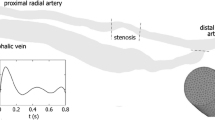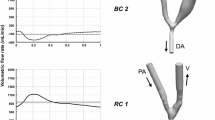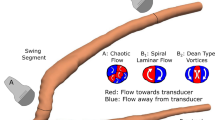Abstract
The arteriovenous fistula (AVF) is commonly faced with stenosis at the juxta-anastomotic (JXA) region of the vein. Implantation of a flexible nitinol stent across the stenosed JXA has led to the retention of functioning AVFs leading to the resulting AVF geometry being distinctly altered, thereby affecting the haemodynamic environment within it. In this study, large eddy simulations of the flow field within a patient-specific AVF geometry before and after stent implantation were conducted to detail the change in flow features. Although the diseased AVF had much lower flow rates, adverse flow features, such as recirculation zones and swirling flow at the anastomosis, and jet flow at the stenosis site were present. Larger velocity fluctuations (leading to higher turbulent kinetic energy) stemming from these flow features were apparent in the diseased AVF compared to the stented AVF. The unsteadiness at the stenosis created large regions of wall shear stress (WSS) fluctuations downstream of the stenosis site that were not as apparent in the stented AVF geometry. The larger pressure drop across the diseased vein, compared to the stented vein, was primarily caused by the constriction at the stenosis, potentially causing the lower flow rate. Furthermore, the WSS fluctuations in the diseased AVF could lead to further disease progression downstream of the stenosis. The change in bulk flow unsteadiness, pressure drop, and WSS behaviour confirms that the haemodynamic environment of the diseased AVF has substantially improved following the flexible stent implantation.












Similar content being viewed by others
Data Availability
Original raw data are unable to be shared due to our ethics clearance; however, data post-processing algorithms are available on request.
References
Anwar S, Vachharajani TJ (2017) Stent use for hemodialysis access: what a general nephrologist needs to know. Hemodial Int 22:143–149
Berry JL, Santamarina A, Moore JE, Roychowdhury S, Routh WD (2000) Experimental and computational flow evaluation of coronary stents. Ann Biomed Eng 28(4):386–398
Blackburn HM, Sherwin SJ (2007) Instability modes and transition of pulsatile stenotic flow: pulse-period dependence. J Fluid Mech 573:57–88
Bozzetto M, Ene-Iordache B, Remuzzi A (2016) Transitional flow in the venous side of patient-specific arteriovenous fistulae for hemodialysis. Ann Biomed Eng 44(8):2388–2401. https://doi.org/10.1007/s10439-015-1525-y
Bozzetto M, Soliveri L, Poloni S, Brambilla P, Curtò D, Condemi GC, Cefalì P, Spina I, Villa A, Caroli A, et al (2022) Arteriovenous fistula creation with VasQ™ device: a feasibility study to reveal hemodynamic implications. J Vasc Access, 11297298221087160
Carroll JE, Colley ES, Thomas SD, Varcoe RL, Simmons A, Barber TJ (2020) Tracking geometric and hemodynamic alterations of an arteriovenous fistula through patient-specific modelling. Comput Methods Programs Biomed 186:105203
Celik IB, Ghia U, Roache PJ et al (2008) Procedure for estimation and reporting of uncertainty due to discretization in \(\{\)CFD$\}$ applications. J Fluids Eng 130(7):078001
Chemla E, Velazquez CC, D’abate F, Ramachandran V, Maytham G (2016) Arteriovenous fistula construction with the VasQ™ external support device: a pilot study. J Vasc Access 17(3):243–248
Cho YI, Kensey KR (1991) Effects of the non-Newtonian viscosity of blood on flows in a diseased arterial vessel. Part 1: steady flows. Biorheology 28(3–4):241–262
Colley E, Carroll J, Thomas S, Varcoe RL, Simmons A, Barber T (2018) A methodology for non-invasive 3-d surveillance of arteriovenous fistulae using freehand ultrasound. IEEE Trans Biomed Eng 65(8):1885–1891
Courant R, Friedrichs K, Lewy H (1967) On the partial difference equations of mathematical physics. IBM J Res Dev 11(2):215–234
Decorato I, Salsac A-V, Legallais C, Alimohammadi M, Diaz-Zuccarini V, Kharboutly Z (2014) Influence of an arterial stenosis on the hemodynamics within an arteriovenous fistula (AVF): comparison before and after balloon-angioplasty. Cardiovasc Eng Technol 5(3):233–243
Duque JC, Tabbara M, Martinez L, Cardona J, Vazquez-Padron RI, Salman LH (2017) Dialysis arteriovenous fistula failure and angioplasty: intimal hyperplasia and other causes of access failure. Am J Kidney Dis 69(1):147–151
Fulker D, Ene-Iordache B, Barber T (2018) High-resolution computational fluid dynamic simulation of haemodialysis cannulation in a patient-specific arteriovenous fistula. J Biomech Eng 140(3):031011
Gunasekera S, Ng O, Thomas S, Varcoe R, de Silva C, Barber T (2020a) Tomographic PIV analysis of physiological flow conditions in a patient-specific arteriovenous fistula. Exp Fluids 61(12):1–14
Gunasekera S, Ng O, Thomas S, Varcoe R, de Silva C, Barber T (2020b) A numerical investigation of a stented arteriovenous fistula. In: Chanson H, Brown R (eds) Proceedings of the 22nd Australasian fluid mechanics conference. The University of Queensland, St Lucia
Gunasekera S, Ng O, Thomas S, Varcoe R, de Silva C, Barber T (2021) Impact of juxta-anastomotic stent implantation on the haemodynamics within a single representative patient AVF. Int J Heat Fluid Flow 92:108874
Gunasekera S, Barber T, Ng O, Thomas S, Varcoe R, de Silva C (2022) Mitigation of the turbulence within an arteriovenous fistula with a stent implantation. Phys Rev Fluids 7:123101. https://doi.org/10.1103/PhysRevFluids.7.123101
He X, Ku DN (1996) Pulsatile flow in the human left coronary artery bifurcation: average conditions. J Biomech Eng 118(1):74–82
Hunt JC, Wray AA, Moin P (1988) Eddies, streams, and convergence zones in turbulent flows. In: Studying turbulence using numerical simulation databases, 2. Proceedings of the 1988 summer program
Jabir E, Lal SA (2016) Numerical analysis of blood flow through an elliptic stenosis using large eddy simulation. Proc Inst Mech Eng Part H 230(8):709–726
Johari N, Wood N, Cheng Z, Torii R, Oishi M, Oshima M, Xu X (2019) Disturbed flow in a stenosed carotid artery bifurcation: comparison of rans-based transitional model and les with experimental measurements. Int J Appl Mech 11(04):1950032
Köhler B, Gasteiger R, Preim U, Theisel H, Gutberlet M, Preim B (2013) Semi-automatic vortex extraction in 4D PC-MRI cardiac blood flow data using line predicates. IEEE Trans Vis Comput Graph 19(12):2773–2782
Lantz J, Gårdhagen R, Karlsson M (2012) Quantifying turbulent wall shear stress in a subject specific human aorta using large eddy simulation. Med Eng Phys 34(8):1139–1148
Liyanage T, Ninomiya T, Jha V, Neal B, Patrice HM, Okpechi I, Zhao M-H, Lv J, Garg AX, Knight J et al (2015) Worldwide access to treatment for end-stage kidney disease: a systematic review. The Lancet 385(9981):1975–1982
Lok CE, Huber TS, Lee T, Shenoy S, Yevzlin AS, Abreo K, Allon M, Asif A, Astor BC, Glickman MH et al (2020) Kdoqi clinical practice guideline for vascular access: 2019 update. Am J Kidney Dis 75(4):1–164
Mallik M, Sivaprakasam R, Pettigrew GJ, Callaghan CJ (2011) Operative salvage of radiocephalic arteriovenous fistulas by formation of a proximal neoanastomosis. J Vasc Surg 54(1):168–173
Manchester EL, Pirola S, Salmasi MY, O’Regan DP, Athanasiou T, Xu XY (2021) Analysis of turbulence effects in a patient-specific aorta with aortic valve stenosis. Cardiovasc Eng Technol 12:1–16
McGah PM, Leotta DF, Beach KW, Aliseda A (2014) Effects of wall distensibility in hemodynamic simulations of an arteriovenous fistula. Biomech Model Mechanobiol 13(3):679–695
Ng O, Gunasekera S, Thomas S, Varcoe R, Barber T (2020) A clinical predictive indicator for arteriovenous fistula (AVF) failure. In: Chanson H, Brown R (eds) Proceedings of the 22nd Australasian fluid mechanics conference. The University of Queensland, St Lucia
Northrup H, Somarathna M, Corless S, Falzon I, Totenhagen J, Lee T, Shiu Y-T (2021) Analysis of geometric and hemodynamic profiles in rat arteriovenous fistula following PDE5A inhibition. Front Bioeng Biotechnol 9:779043
Pal A, Anupindi K, Delorme Y, Ghaisas N, Shetty DA, Frankel SH (2014) Large eddy simulation of transitional flow in an idealized stenotic blood vessel: evaluation of subgrid scale models. J Biomech Eng 136(7):071009
Pope SB (2001) Turbulent flows. Meas Sci Technol 12(11):2020–2021. https://doi.org/10.1088/0957-0233/12/11/705
Roy-Chaudhury P, Sukhatme VP, Cheung AK (2006) Hemodialysis vascular access dysfunction: a cellular and molecular viewpoint. J Am Soc Nephrol 17(4):1112–1127
Santoro D, Benedetto F, Mondello P, Pipitò N, Barillà D, Spinelli F, Ricciardi CA, Cernaro V, Buemi M (2014) Vascular access for hemodialysis: current perspectives. Int J Nephrol Renov Dis 7:281
Stolic R (2013) Most important chronic complications of arteriovenous fistulas for hemodialysis. Med Princ Pract 22(3):220–228
Thomas SD, Peden S, Crowe P, Varcoe RL (2019) Interwoven nitinol stents to treat radiocephalic anastomotic arteriovenous fistula stenosis. J Endovasc Ther 26(3):394–401
Thomas SD, Peden S, Katib N, Crowe P, Barber T, Varcoe RL (2023) Long-term results of interwoven nitinol stents to treat the radiocephalic anastomotic arteriovenous fistula stenosis. J Endovasc Ther 30(2):176–184
Valen-Sendstad K, Piccinelli M, Steinman DA (2014) High-resolution computational fluid dynamics detects flow instabilities in the carotid siphon: implications for aneurysm initiation and rupture? J Biomech 47(12):3210–3216
Varghese SS, Frankel SH, Fischer PF (2007) Direct numerical simulation of stenotic flows. Part 2. Pulsatile flow. J Fluid Mech 582:281–318
Vijayaratnam PR, O’Brien CC, Reizes JA, Barber TJ, Edelman ER (2015) The impact of blood rheology on drug transport in stented arteries: steady simulations. PLoS ONE 10(6):e0128178
Wang C, Baker BM, Chen CS, Schwartz MA (2013) Endothelial cell sensing of flow direction. Arterioscler Thromb Vasc Biol 33(9):2130–2136
Xu H, Xiong J, Han X, Mei Y, Shi Y, Wang D, Zhang M, Chen D (2021) Computed tomography-based hemodynamic index for aortic dissection. J Thorac Cardiovasc Surg 162(2):165–176
Acknowledgements
Sanjiv Gunasekera and Olivia Ng were recipients of the Australian Government Research Training Program Scholarship during the course of this work and gratefully acknowledge this support.
This research/project was undertaken with the assistance of resources and services from the National Computational Infrastructure (NCI), which is supported by the Australian Government.
Funding
No funding was received for conducting this study.
Author information
Authors and Affiliations
Contributions
SG, CdS, ON, ST, RV, TB were involved in conceptualisation; SG, ON, TB contributed to methodology; SG, ON were involved in data curation; SG, CdS, TB contributed to formal analysis and investigation; CdS, ST, RV, TB were involved in supervision; SG contributed to visualisation and writing—original draft; SG, CdS, ON, ST, RV, TB were involved in writing—review and editing.
Corresponding author
Ethics declarations
Conflict of interest
Shannon Thomas reports a relationship with Abbott Vascular, Medtronic, W. L. Gore, Bio-Excel, and Shockwave that includes: consulting or advisory, funding grants, paid expert testimony, speaking and lecture fees, and travel reimbursement. Shannon Thomas is a shareholder and chief medical officer in Vexev. Ramon Varcoe reports a relationship with Abbott Vascular, Medtronic, InterVene Inc., Surmodics, Philips, BD Bard Inc., Boston Scientific, W. L. Gore, and Nectero that includes: consulting or advisory fees. Ramon Varcoe is a shareholder in EBR systems and Provision Inc. Tracie Barber reports a relationship with Abbott Vascular that includes: consulting or advisory.
Ethics approval
The patient’s data were obtained after informed consent was given under the Low/Negligible Risk (LNR) Application with the Human Research Ethics Committee number 15/063 (LNR/16/POWH/7). The ethics for the related longitudinal study was updated under the Human Research Ethics Application ID 2018/ETH00577.
Additional information
Publisher's note
Springer Nature remains neutral with regard to jurisdictional claims in published maps and institutional affiliations.
Rights and permissions
Springer Nature or its licensor (e.g. a society or other partner) holds exclusive rights to this article under a publishing agreement with the author(s) or other rightsholder(s); author self-archiving of the accepted manuscript version of this article is solely governed by the terms of such publishing agreement and applicable law.
About this article
Cite this article
Gunasekera, S., de Silva, C., Ng, O. et al. Stenosis to stented: decrease in flow disturbances following stent implantation of a diseased arteriovenous fistula. Biomech Model Mechanobiol 23, 453–468 (2024). https://doi.org/10.1007/s10237-023-01784-5
Received:
Accepted:
Published:
Issue Date:
DOI: https://doi.org/10.1007/s10237-023-01784-5




